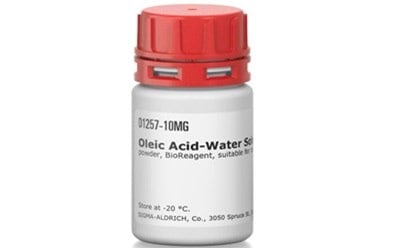Oleic Acid

Oleic Acid is a naturally colorless liquid oil similar to an omega-9 oil, which turns yellow or brown when exposed to air. It is an octadec-9-enoic acid with a cis double bond at C-9 and is considered the most abundant monounsaturated fatty acid in nature. Oleic acid has a mild odor, floats on water, and plays multiple roles, including being an EC 3.1.1.1 (carboxylesterase) inhibitor, an Escherichia coli metabolite, a plant metabolite, a Daphnia galeata metabolite, a solvent, an antioxidant, and a mouse metabolite. It acts as a conjugate acid of an oleate and derives from a hydride of a cis-octadec-9-ene. This component can be found in plant sources such as Gladiolus italicus, and Prunus mume, as well as in animal origins like pigs. Vegetable oleic acid is obtained through the hydrolysis of olive-pomace oleins, followed by subsequent distillation. Meanwhile, animal-derived oleic acid is obtained by hydrolyzing animal fat (tallow), conducting cold fractionation, and then distilling the resulting mixture.
Products
Products
Oleic Acid Properties and Applications
Oleic acid is a versatile substance with a wide range of properties and applications. Depending on the source of the oil, it finds use in various sectors. It is utilized in industries producing detergents, textiles, paints, inks, cosmetics, pharmaceuticals, leather, and lubricants. With excellent skin-penetrating qualities, it outperforms vegetable oils, finding application in soft soap, permanent wave solutions, nail polish, toilet soaps, and liquid makeup. Valued in pharmaceuticals, textiles, metallurgy, and chemicals, oleic acid stands as a versatile ingredient that addresses challenges across various industries, creating essential components and solutions.
Furthermore, oleic acid serves as an emollient and is used in pharmaceuticals as an excipient. It also functions as an emulsifying or solubilizing agent in aerosol products. Notably, it has been demonstrated that oleic acid plays a crucial role in the growth and productivity of Chinese Hamster Ovary (CHO) cells. In cell culture systems, oleic acid fulfills functions such as long-term energy storage. The energy derived from NADPH and ATP is stored in the form of fatty acids. These fatty acids are esterified to a glycerol backbone, forming compounds known as mono-, di-, and tri-glycerides (neutral fats). The degradation of fatty acids releases stored energy, contributing to cellular processes. This highlights the importance of oleic acid in various applications, encompassing both industrial and research domains.
Oleic Acid as A Standard
Oleic acid is used as a pharmaceutical reference standard for assessing analytes in pharmaceutical formulations through chromatography techniques such as high-performance liquid chromatography (HPLC) and gas chromatography (GC). Also, it serves as an analytical standard for identifying and quantifying fatty acids in blood plasma samples using gas chromatography combined with vacuum ultraviolet spectroscopy.
Oleic Acid as A Bioreagent
Powdered oleic acid, which is water-soluble, and oleic acid-albumin from bovine are used as bioreagents in cell culture.
Labeled Oleic Acids
Isotopically labeled oleic acids (Oleic acid-1-13C) can be used to examine lipid metabolism in cells and organisms, investigate the process of fatty acid oxidation, explore lipid molecules within a biological system, and analyze protein-lipid interactions.
Deuterated Oleic Acids
Deuterated oleic acids are used in NMR spectroscopy for investigating molecular structures, conformational changes, and atomic-level interactions. They are also utilized to trace metabolic pathways and in pharmacokinetic studies aimed at examining the absorption, distribution, metabolism, and excretion of lipids and lipid-based compounds in the body.
Oleic Acid Salts
Oleic acid salts (Sodium oleate and potassium oleate) are used as surfactants and emulsifiers in food products. They are also used in textile processing as leveling agents to ensure even dye distribution during dyeing processes, as dispersing agents in the production of paper and pulp, and as foaming agents in the manufacturing of foamed rubber and latex products.
Related Product Resources
- Oleic Acid in Cell Culture
How the unsaturated fatty acid, oleic acid and other cell culture components affect the performance of serum-free, protein-free cell culture systems used for biomanufacturing heterologous proteins including monoclonal antibodies.
To continue reading please sign in or create an account.
Don't Have An Account?